In 1918, the Hungarian silent cinema was at its best. An amazing amount of talent in Budapest was producing one film after another. Among them were the directors Alexander Korda and Michael Curtiz, and actors like Béla Lugosi, Vilma Bánky, Paul Lukas and Lya de Putti. Pál Funk was the major photographer of the film community. He worked under the name of Angelo and his glamorous film star portraits graced countless European postcards. Today EFSP presents a post with portraits he all made in Budapest in 1918. They were used for Hungarian postcards and for German postcards by the NPG (Neue Photografische Gesellschaft).

German postcard by NPG, no. 982. Photo: Angelo, Budapest, 1918.
Lili Berky (1886–1958), aka Lilli Berky and Lili Berki, was a Hungarian stage and screen actress, who starred in over 30 Hungarian silent films between 1913 and the late 1920s and played in an equal amount of Hungarian sound films, mainly in the 1930s and early 1940s. In 1917 she became the wife of Hungarian actor and comedian Gyula Gózon. They often performed together.

German postcard by NPG, no. 984. Photo: Angelo, Budapest, 1918.
Ilona Dömötör was a Hungarian stage actress. As far as known, she only acted in one silent film, A fogadalom/The vow (J. Béla Geröffy, 1921). Very little is known about her.
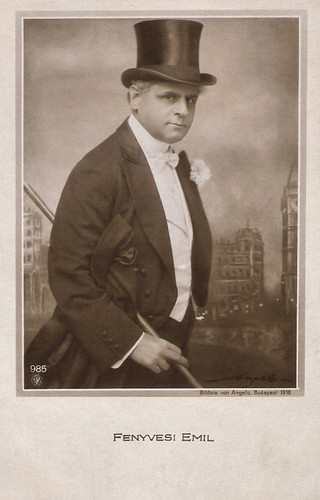
German postcard by NPG, no. 985. Photo: Angelo, Budapest, 1918.
Emil Fenyvesy (1859–1924) was a monstre sacré of the Hungarian stage, who also acted in some 23 Hungarian silent films between 1912 and 1923. He was in his fifties when he started as a screen actor. He first acted in four films by Sándor Góth: Víg özvegy (1912) with Ferenc Vendrey and Ica von Lenkeffy, A páter és a Péter (1912), again with Vendrey, A Marhakereskedö (1913), and A csikós (1913). Then he played a rabbi in Alexander Korda's Lyon Lea (1915). In 1917-1919 he peaked with 6 to 8 films per year, in Hungarian silent films by mainly Márton Garas. He was Karenin in Anna Karenina (1918), played opposite Leopoldine Konstantin and Dezsõ Kertész in A Táncosnö/The dancer (1919) and was Mr. Brownlow in Oliver Twist (1919). Other directors he worked with were Carl Wilhelm and Alexander Korda. In Tavaszi szerelem (1921) by a young Géza von Bolváry, Fenyvesy acted opposite Vilma Bánky and Norbert Dán. Fenyvesi's last film roles were as a rabbi and father of Ernö Verebes in Péntek este (Alfréd Deésy, 1921), an unknown part in Az egyhuszasos lány (Uwe Jens Krafft, 1923), and as Emperor Franz Joseph in Alexander Korda's Tragödie im Hause Habsburg (1924), a German production about the Mayerling Affair, with Maria Corda as Maria Vetsera, lover of Crown prince Rudolph (Kálmán Zátony). Emil Fenyvesy died in Budapest in 1924.
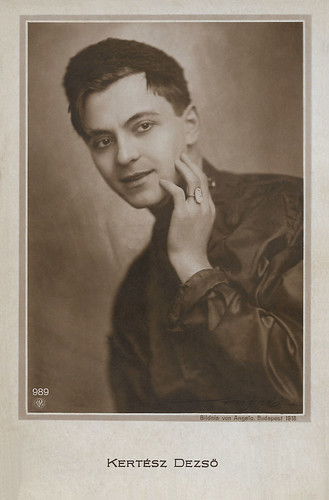
German postcard by NPG, no. 989. Photo: Angelo, Budapest, 1918.
Dezső Kertész (1890-1965) acted in some seven silent Hungarian films in the 1910s and returned to the set in the early sound era and the war years. Kertész debuted on screen as the Baron's son Laszlo in A Falu rossza/The Village Rogue (M. Miklós Pásztory, 1916), based on a play by Ede Tóth, and scripted by Ladislaus Vajda. He then played Absalon opposite Ica Lenkeffy in Szulamit (Jenö Illés, 1916), Dr. Gré in A Nevetö Szaszkia/The Laughing Saskia (Alexander Korda, 1916), A szentjóbi erdö titka/The Secret of St. Job Forest (Michael Curtiz, 1917), Három hét (Márton Garas, 1917) with Sári Fedák and based on Elinor Glyn's 'Three Weeks' about an unhappily married Queen (Fedak) who steps out for three weeks with a dashing count (Kertesz). Similarly, Kertesz played the rich bachelor Vronsky in Márton Garas' adaptation of Anna Karenina (1918), with Irén Varsányi in the title role. In 1919 Kertesz acted opposite Leopoldine Konstantin in A Táncosnö/The Dancer (Márton Garas, 1919), with Konstantin in the title role. All in all, Kertesz acted in some 18 silent Hungarian films until 1921.

German postcard. NPG, no. 994. Photo Angelo, Budapest 1918.
Emmi Kosáry (1889-1964) was a Hungarian opera diva and operetta prima donna with a beautiful soprano voice. She also became a film actress, who worked in Hungary with the young Michael Curtiz. Kosáry was the wife of composer Ákos Buttykay.
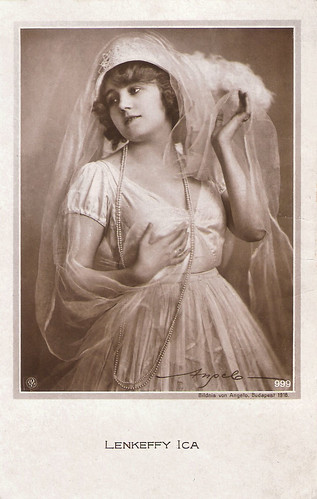
German postcard by NPG, no. 999. Photo: Angelo, Budapest, 1918.

German postcard by NPG, no. 1000. Photo: Angelo, Budapest, 1918.

German postcard by NPG, no. 1062. Photo: Angelo, Budapest 1918.
Ica Lenkeffy aka Ica von Lenkeffy started in film in 1912 with director Sándor (Alexander) Góth, who had just started his career. Her first successful film was Szulamit (Jenő Illés, 1916), set in Old Testaments times and with Dezsõ Kertész as her co-star. Lenkeffy then mostly played in films directed by Márkus László, Bela Balogh, Mihály Kertész (Michael Curtiz) and Sándor (Alexander) Korda. Among her film partners were Alfréd Deésy, Oscar Beregi Sr., Gyula Csortos, Mihály Várkonyi (Victor Varconi), Iván Petrovich, and the later Oscar winner Pál Lukács (Paul Lukas). In 1921 Lenkeffy moved to Vienna and acted in Boccaccio (Michael Curtiz, 1920), also with Paul Lukas. She then moved on to Berlin, where she starred opposite Paul Hartmann in the May-Film production Die Erbin von Tordis (Robert Dinesen, 1921). In the German production of Othello (Dimitri Buchowetzki, 1922), Ica (by now Von) Lenkeffy played Desdemona opposite Emil Jannings as Othello and Werner Krauss as Jago. In 1923 Lenkeffy married Parisian banker Louis Mannheim. She moved to Paris with him, where she lived in luxury, but she retired from the film business at her husband's request.
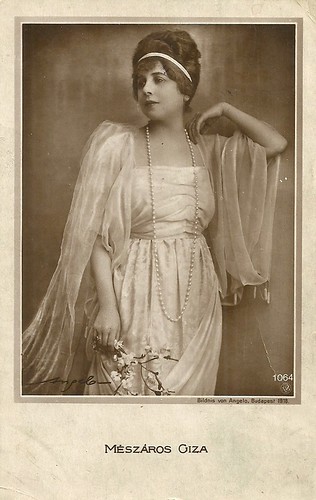
German postcard by NPG, no. 1064. Photo: Angelo, Budapest 1918.
Giza Mészáros (1879-1953) was a popular Hungarian stage actress, who also acted in some six silent Hungarian films of the 1910s. Her modest film career started with Egy csók története (Sándor Góth, 1912), which starred her partner Gyula Csortos. Afterward followed A Marhakereskedö (Sándor Góth, 1913), Lotti ezredesei/Colonel Lotti (Peter Paul Felner, 1916) in which she had the lead, A föld embere/Earth's Man (Michael Curtiz, 1917), starring Oscar Beregi as a mine engineer, and finally A hazugság/The Lie (Ödön Uher ifj., 1919), after Paul Bourget's novel 'Mensonges', about a woman with a double life as world-wise, frivolous lover of an older baron, and at the same time the chaste and remorseful lover of a young poet.

German postcard by NPG, no. 1065. Photo: Angelo, Budapest, 1918.
Ilonka [Ilona] Mezey or Mezei was a Hungarian actress, born 1892 in Budapest. She acted e.g. in Udvari levegö (Béla Balogh, 1919), starring Helene von Bolvary, and co-starring Jenö Törzs and Paul Lukas. Mezey also acted in A Kormánybiztos (Károly Lajthay, 1919).
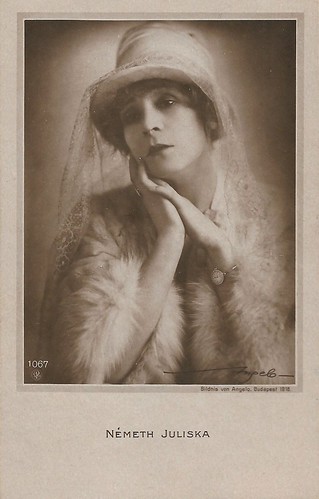
German postcard by NPG, no. 1067. Photo: Angelo, Budapest, 1918.
Juliska Németh (1890-1935) was a popular Hungarian cabaret performer in Hungary, Germany, and Austria, between the 1910s and the early 1930s. As far as known, she only acted in two Hungarian silent films: Júdás (Michael Curtiz, 1918), also with Gyula Gál and Claire Lotto, and Nantas (Béla Balogh, 1920), after Emile Zola's novel.

German postcard by NPG, no. 1275 Photo: Angelo, Budapest, 1918.
Hungarian stage and film actor Oscar Beregi, Sr. (1876-1965) appeared in 27 European and American films between 1916 and 1953. He is remembered as Dr. Baum in Fritz Lang’s Das Testament des Dr. Mabuse (1933).

German postcard by NPG, no. 1963. Photo Angelo, Budapest, 1918.
Ila Loth (1899-1975) was a Hungarian actress of the silent screen.
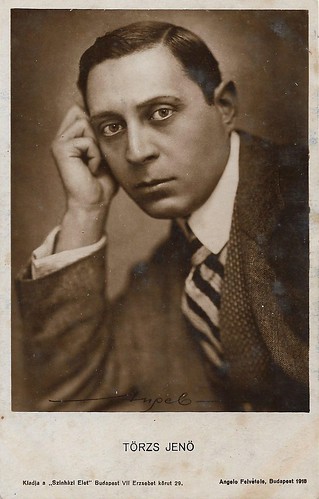
Hungarian postcard by Szinhazi Elet, Budapest. Photo: Angelo, Budapest, 1918.
Jenö Törzs (1887–1946) was a Hungarian stage and screen actor, who acted in over 20 Hungarian films in the 1910s, and returned to the screen in 10 more Hungarian films during the 1930s. Törzs was primarily a stage actor, playing great prose roles for many years on stage, often with Gyula Csortos as his antagonist. Törzs was able to keep his high quality on the film screen, appearing in some 20 early Hungarian silent films. He started in 1914 at Pathé Frères' Hungarian studio, in Sárga liliom (László Beöthy, Félix Vanyl, 1914), but it was really from 1917 onward, that he acted in 4 to 6 films a year between 1917 and 1921, such as A szentjóbi erdö titka (Michael Curtiz, 1917) with Dezsö Kertész, Vengerkák (Bela Balogh, 1917) with Ica Lenkeffy, Érdekházasság/Marriage interest (Antal Forgács, 1918) - an Elinor Glyn adaptation in which Törsz had the lead, Az isten fia és az ördög fia (Lajos Lázár, 1918) - again a lead, A csavargó/The tramp (Paul Sugar 1918) with Lya de Putti, Hivatalnok urak/Officers and gentlemen (Béla Balogh, 1919) - again, a lead - and Olivér Twist (Márton Garas, 1919) with László Z. Molnár as Fagin.
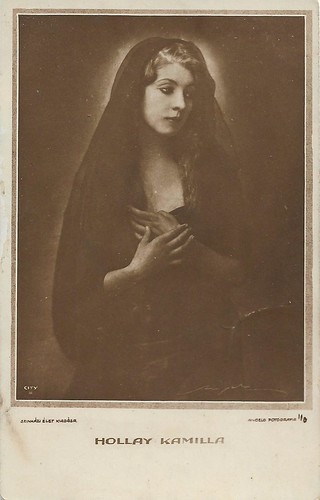
Hungarian postcard by Shinhazi Elet, Budapest, no. 111. Photo: Angelo, Budapest, 1918.
Camilla von Hollay (Kamilla Hollay) (1899–1967) was a Hungarian film actress of the silent era. She appeared in more than 40 films between 1916 and 1930.
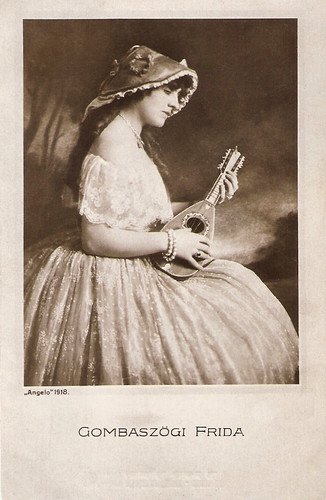
Hungarian postcard by Reinitz Jòzsef, Budapest / Terjeszti Gonda Oszkàr, Budapest. Photo: Angelo, 1918.
During her long and impressive career, Hungarian stage actress Frida Gombaszögi (1890–1961) appeared only in two, silent films. She was the first Hungarian actress who represented the modern acting style in plays by Molnar, Chekhov and Gorky.
Sources: Wikipedia (Hungarian) and IMDb.

German postcard by NPG, no. 982. Photo: Angelo, Budapest, 1918.
Lili Berky (1886–1958), aka Lilli Berky and Lili Berki, was a Hungarian stage and screen actress, who starred in over 30 Hungarian silent films between 1913 and the late 1920s and played in an equal amount of Hungarian sound films, mainly in the 1930s and early 1940s. In 1917 she became the wife of Hungarian actor and comedian Gyula Gózon. They often performed together.

German postcard by NPG, no. 984. Photo: Angelo, Budapest, 1918.
Ilona Dömötör was a Hungarian stage actress. As far as known, she only acted in one silent film, A fogadalom/The vow (J. Béla Geröffy, 1921). Very little is known about her.

German postcard by NPG, no. 985. Photo: Angelo, Budapest, 1918.
Emil Fenyvesy (1859–1924) was a monstre sacré of the Hungarian stage, who also acted in some 23 Hungarian silent films between 1912 and 1923. He was in his fifties when he started as a screen actor. He first acted in four films by Sándor Góth: Víg özvegy (1912) with Ferenc Vendrey and Ica von Lenkeffy, A páter és a Péter (1912), again with Vendrey, A Marhakereskedö (1913), and A csikós (1913). Then he played a rabbi in Alexander Korda's Lyon Lea (1915). In 1917-1919 he peaked with 6 to 8 films per year, in Hungarian silent films by mainly Márton Garas. He was Karenin in Anna Karenina (1918), played opposite Leopoldine Konstantin and Dezsõ Kertész in A Táncosnö/The dancer (1919) and was Mr. Brownlow in Oliver Twist (1919). Other directors he worked with were Carl Wilhelm and Alexander Korda. In Tavaszi szerelem (1921) by a young Géza von Bolváry, Fenyvesy acted opposite Vilma Bánky and Norbert Dán. Fenyvesi's last film roles were as a rabbi and father of Ernö Verebes in Péntek este (Alfréd Deésy, 1921), an unknown part in Az egyhuszasos lány (Uwe Jens Krafft, 1923), and as Emperor Franz Joseph in Alexander Korda's Tragödie im Hause Habsburg (1924), a German production about the Mayerling Affair, with Maria Corda as Maria Vetsera, lover of Crown prince Rudolph (Kálmán Zátony). Emil Fenyvesy died in Budapest in 1924.

German postcard by NPG, no. 989. Photo: Angelo, Budapest, 1918.
Dezső Kertész (1890-1965) acted in some seven silent Hungarian films in the 1910s and returned to the set in the early sound era and the war years. Kertész debuted on screen as the Baron's son Laszlo in A Falu rossza/The Village Rogue (M. Miklós Pásztory, 1916), based on a play by Ede Tóth, and scripted by Ladislaus Vajda. He then played Absalon opposite Ica Lenkeffy in Szulamit (Jenö Illés, 1916), Dr. Gré in A Nevetö Szaszkia/The Laughing Saskia (Alexander Korda, 1916), A szentjóbi erdö titka/The Secret of St. Job Forest (Michael Curtiz, 1917), Három hét (Márton Garas, 1917) with Sári Fedák and based on Elinor Glyn's 'Three Weeks' about an unhappily married Queen (Fedak) who steps out for three weeks with a dashing count (Kertesz). Similarly, Kertesz played the rich bachelor Vronsky in Márton Garas' adaptation of Anna Karenina (1918), with Irén Varsányi in the title role. In 1919 Kertesz acted opposite Leopoldine Konstantin in A Táncosnö/The Dancer (Márton Garas, 1919), with Konstantin in the title role. All in all, Kertesz acted in some 18 silent Hungarian films until 1921.

German postcard. NPG, no. 994. Photo Angelo, Budapest 1918.
Emmi Kosáry (1889-1964) was a Hungarian opera diva and operetta prima donna with a beautiful soprano voice. She also became a film actress, who worked in Hungary with the young Michael Curtiz. Kosáry was the wife of composer Ákos Buttykay.

German postcard by NPG, no. 999. Photo: Angelo, Budapest, 1918.

German postcard by NPG, no. 1000. Photo: Angelo, Budapest, 1918.

German postcard by NPG, no. 1062. Photo: Angelo, Budapest 1918.
Ica Lenkeffy aka Ica von Lenkeffy started in film in 1912 with director Sándor (Alexander) Góth, who had just started his career. Her first successful film was Szulamit (Jenő Illés, 1916), set in Old Testaments times and with Dezsõ Kertész as her co-star. Lenkeffy then mostly played in films directed by Márkus László, Bela Balogh, Mihály Kertész (Michael Curtiz) and Sándor (Alexander) Korda. Among her film partners were Alfréd Deésy, Oscar Beregi Sr., Gyula Csortos, Mihály Várkonyi (Victor Varconi), Iván Petrovich, and the later Oscar winner Pál Lukács (Paul Lukas). In 1921 Lenkeffy moved to Vienna and acted in Boccaccio (Michael Curtiz, 1920), also with Paul Lukas. She then moved on to Berlin, where she starred opposite Paul Hartmann in the May-Film production Die Erbin von Tordis (Robert Dinesen, 1921). In the German production of Othello (Dimitri Buchowetzki, 1922), Ica (by now Von) Lenkeffy played Desdemona opposite Emil Jannings as Othello and Werner Krauss as Jago. In 1923 Lenkeffy married Parisian banker Louis Mannheim. She moved to Paris with him, where she lived in luxury, but she retired from the film business at her husband's request.

German postcard by NPG, no. 1064. Photo: Angelo, Budapest 1918.
Giza Mészáros (1879-1953) was a popular Hungarian stage actress, who also acted in some six silent Hungarian films of the 1910s. Her modest film career started with Egy csók története (Sándor Góth, 1912), which starred her partner Gyula Csortos. Afterward followed A Marhakereskedö (Sándor Góth, 1913), Lotti ezredesei/Colonel Lotti (Peter Paul Felner, 1916) in which she had the lead, A föld embere/Earth's Man (Michael Curtiz, 1917), starring Oscar Beregi as a mine engineer, and finally A hazugság/The Lie (Ödön Uher ifj., 1919), after Paul Bourget's novel 'Mensonges', about a woman with a double life as world-wise, frivolous lover of an older baron, and at the same time the chaste and remorseful lover of a young poet.

German postcard by NPG, no. 1065. Photo: Angelo, Budapest, 1918.
Ilonka [Ilona] Mezey or Mezei was a Hungarian actress, born 1892 in Budapest. She acted e.g. in Udvari levegö (Béla Balogh, 1919), starring Helene von Bolvary, and co-starring Jenö Törzs and Paul Lukas. Mezey also acted in A Kormánybiztos (Károly Lajthay, 1919).

German postcard by NPG, no. 1067. Photo: Angelo, Budapest, 1918.
Juliska Németh (1890-1935) was a popular Hungarian cabaret performer in Hungary, Germany, and Austria, between the 1910s and the early 1930s. As far as known, she only acted in two Hungarian silent films: Júdás (Michael Curtiz, 1918), also with Gyula Gál and Claire Lotto, and Nantas (Béla Balogh, 1920), after Emile Zola's novel.

German postcard by NPG, no. 1275 Photo: Angelo, Budapest, 1918.
Hungarian stage and film actor Oscar Beregi, Sr. (1876-1965) appeared in 27 European and American films between 1916 and 1953. He is remembered as Dr. Baum in Fritz Lang’s Das Testament des Dr. Mabuse (1933).

German postcard by NPG, no. 1963. Photo Angelo, Budapest, 1918.
Ila Loth (1899-1975) was a Hungarian actress of the silent screen.

Hungarian postcard by Szinhazi Elet, Budapest. Photo: Angelo, Budapest, 1918.
Jenö Törzs (1887–1946) was a Hungarian stage and screen actor, who acted in over 20 Hungarian films in the 1910s, and returned to the screen in 10 more Hungarian films during the 1930s. Törzs was primarily a stage actor, playing great prose roles for many years on stage, often with Gyula Csortos as his antagonist. Törzs was able to keep his high quality on the film screen, appearing in some 20 early Hungarian silent films. He started in 1914 at Pathé Frères' Hungarian studio, in Sárga liliom (László Beöthy, Félix Vanyl, 1914), but it was really from 1917 onward, that he acted in 4 to 6 films a year between 1917 and 1921, such as A szentjóbi erdö titka (Michael Curtiz, 1917) with Dezsö Kertész, Vengerkák (Bela Balogh, 1917) with Ica Lenkeffy, Érdekházasság/Marriage interest (Antal Forgács, 1918) - an Elinor Glyn adaptation in which Törsz had the lead, Az isten fia és az ördög fia (Lajos Lázár, 1918) - again a lead, A csavargó/The tramp (Paul Sugar 1918) with Lya de Putti, Hivatalnok urak/Officers and gentlemen (Béla Balogh, 1919) - again, a lead - and Olivér Twist (Márton Garas, 1919) with László Z. Molnár as Fagin.

Hungarian postcard by Shinhazi Elet, Budapest, no. 111. Photo: Angelo, Budapest, 1918.
Camilla von Hollay (Kamilla Hollay) (1899–1967) was a Hungarian film actress of the silent era. She appeared in more than 40 films between 1916 and 1930.

Hungarian postcard by Reinitz Jòzsef, Budapest / Terjeszti Gonda Oszkàr, Budapest. Photo: Angelo, 1918.
During her long and impressive career, Hungarian stage actress Frida Gombaszögi (1890–1961) appeared only in two, silent films. She was the first Hungarian actress who represented the modern acting style in plays by Molnar, Chekhov and Gorky.
Sources: Wikipedia (Hungarian) and IMDb.
No comments:
Post a Comment